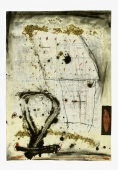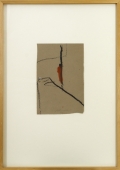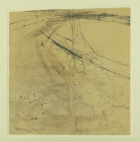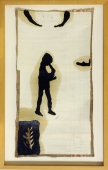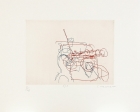
Artist | Pablo Gargallo (1881 - 1934)
https://www.artist-info.com/artist/Pablo-Gargallo
Exhibition at IVAM, Valencia
Exhibition at IVAM, Valencia
PABLO GARGALLO
IVAM Centre Julio González
29 January – 2 May, 2004
Curator: Rafael Ordóñez Fernández
The exhibition organised by the IVAM comprises 126 sculptures, 50 drawings, 10 pieces of jewellery and about 20 cardboard templates. The curator of this exhibition, Rafael Ordóñez Fernández, has established several periods in Gargallo's sculpture defined by the different materials used in his work.
The catalogue of the exhibition includes texts by Josefina Alix, Alejandro J. Ratia, Antonio Ansón, Francesc Fontbona and the curator.
The great sculptor Pablo Gargallo was born in Maella (Zaragoza) in 1881 and died in Reus (Tarragona) in 1934. He moved to Barcelona with his family in 1888, where he began to work in a pottery workshop and became an apprentice in the studio of the Moderniste sculptor Eusebi Arnau i Mascort from 1895 to 1903.
He initiated his first studies at the same time, at La Lonja fine arts school in Barcelona, where he began to make drawings and sketches of the human body. He was a regular member of the tertulias held at Les Quatre Gats, where he met many important artists of that time.
In 1903 he was awarded a scholarship to Paris to broaden his studies, but did not stay very long. He returned to Barcelona and held his first solo exhibition at the Sala Parés in 1905. At the same time he worked as an assistant to several sculptors and collaborated with the architect Domènech i Montaner in the Moderniste sculptural decoration of several projects. Between 1905 and 1911 he went through a period of research and consolidation, during which he went beyond the trends of the moment and began to use his own personal language with a firm desire to simplify and synthesise forms and essentialise volumes, that is, to produce a more modern form of expression. From this time onwards, Gargallo felt ready to use different materials in his sculpture.
The first period, known as the copper period, goes from 1910-11 to 1920-21, and was developed between Paris and Barcelona. He concentrated mainly on works in sheet metal, especially copper, most of which were convex in shape. An outstanding piece from this time is Cabeza de Napolitano, of 1914. But since in successive periods he did not relinquish his more classicist side, it is also worth mentioning Retrato de Picasso (Portrait of Picasso), 1913. He took part in several exhibitions, and in 1912 he settled in Paris, where he met his future wife, Magali Tartanson, and important figures like Jacob, Modigliani, Gris, Picasso and González. In 1914 he travelled to Barcelona, where he held another solo exhibition, and in 1920 he was appointed sculpture professor at the Fine Arts School and later at the Superior Fine Arts School in Barcelona.
Between 1920 and 1923, Ordóñez marks a period that he calls the intermediate lead period, where he made a series of changes not only in material but also in technique. He adopted an innovating procedure, modelling negative or concave volumes, in other words, inverting volumes, as in Mujer acostada (Reclining Female), 1923.
His return to Paris defines his second period, where he uses mostly copper and begins to use cardboard templates as patterns, which allows him to ensure the design process, save material and obtain different versions. He starts to make his first concave masks, like Pequeña máscara de star (2ª version), 1928. In Pequeña bailarina española (Little Spanish Dancer), 1927, he incorporates for the first time a complete vacuum perpendicular to the work; in other words, he eliminates material altogether. This feature is one of Gargallo's main contributions to contemporary sculpture. He practised and perfected this innovation throughout his career. Although he was a long way away from Barcelona, he kept in touch with the art world there and continued to receive commissions, such as several sculptures for the new Olympic stadium in Montjüic.
His iron period starts in 1929 with the preferential use of this material; he incorporates total vacuum in large-size sculptures and the elimination and fragmentation of important parts of the figure. Using this material posed certain difficulties, such as the use of the forge and suitable procedures. An outstanding work of this period is Gran Arlequín (Large Harlequin), 1931.
In 1934 his first exhibition in the United States at the Brummer Gallery in New York was acclaimed with good reviews. He returned to Spain exhausted, and contracted a disease that was to put an end to his life, just when he was beginning to be recognised as a master of contemporary sculpture.
This exhibition will travel to the gallery of Biarritz City Hall in June 2004.
 offers / Requests offers / Requests  |
About this service |
|---|
 Exhibition Announcements Exhibition Announcements  |
About this service |
|---|
 Visualization |
Learn more about this service | ||
|---|---|---|---|

Interested in discovering more of this artist's networks?
3 easy steps: Register, buy a package for a visualization, select the artist.
See examples how visualization looks like for an artist, a curator, or an exhibition place: Gallery, museum, non-profit place, or collector.

Exhibition History

|
SUMMARY based on artist-info records. More details and Visualizing Art Networks on demand. Venue types: Gallery / Museum / Non-Profit / Collector |
||||||||||||
| Exhibitions in artist-info | 30 (S 8/ G 22) |
Did show together with - Top 5 of 706 artists (no. of shows) - all shows - Top 100 |
||||||||||
| Exhibitions by type | 30: 3 / 17 / 10 / 0 | |||||||||||
| Venues by type | 22: 3 / 9 / 10 / 0 | |||||||||||
| Curators | 19 | |||||||||||
| artist-info records | Jul 1927 - Jan 2011 | |||||||||||
|
Countries - Top 5 of 9 Germany (8) United States (7) France (7) Switzerland (2) Spain (2) |
Cities - Top 5 of 18 Paris (6) New York (6) Duisburg (3) London (1) Stuttgart (1) |
Venues (no. of shows )
Top 5 of 22
|
||||||||||
Curators (no. of shows)
Top 5 of 19
|
| Solomon R. Guggenheim Museum - SRGM | G | Oct 2010 - Jan 2011 | New York | (397) | +1 | |
| Silver, Kenneth E. (Curator) | +0 | |||||
| Hsu, Helen (Curator) | +0 | |||||
| Greene, Vivien (Curator) | +0 | |||||
| Fundación Botín | S | Mar 2010 - May 2010 | Santander | (17) | +0 | |
| Salazar, María José (Curator) | +0 | |||||
| Wilhelm Lehmbruck Museum | G | Sep 2006 - Jan 2007 | Duisburg | (240) | +0 | |
| Institut Valencià d’Art Modern - Centre Julio Gonzalez (IVAM) | S | Jan 2004 - May 2004 | Valencià | (98) | +0 | |
| Musée d'Art Moderne de la Ville de Paris - MAM (1/2) | G | Nov 2000 - Mar 2001 | Paris | (808) | +0 | |
| Andral, Jean-Louis (Curator) | +0 | |||||
| Krebs, Sophie (Curator) | +0 | |||||
| Marwan Hoss Gallery | S | Nov 1998 - Jan 1999 | Bruxelles | (2) | +0 | |
| Keep reading |














